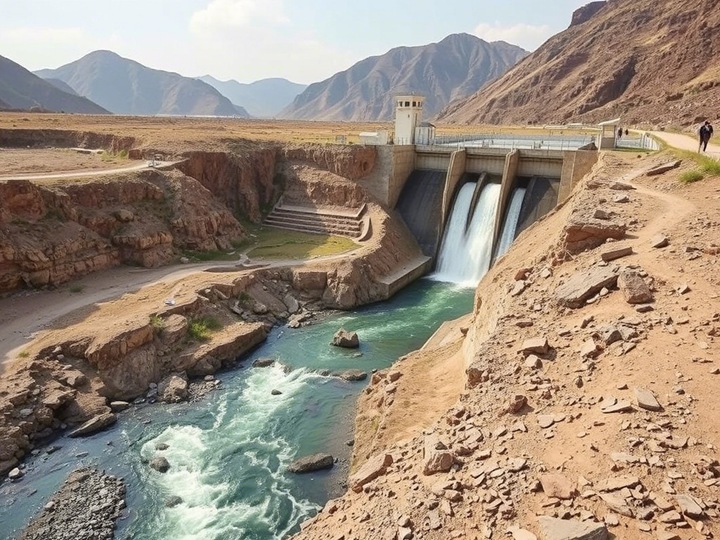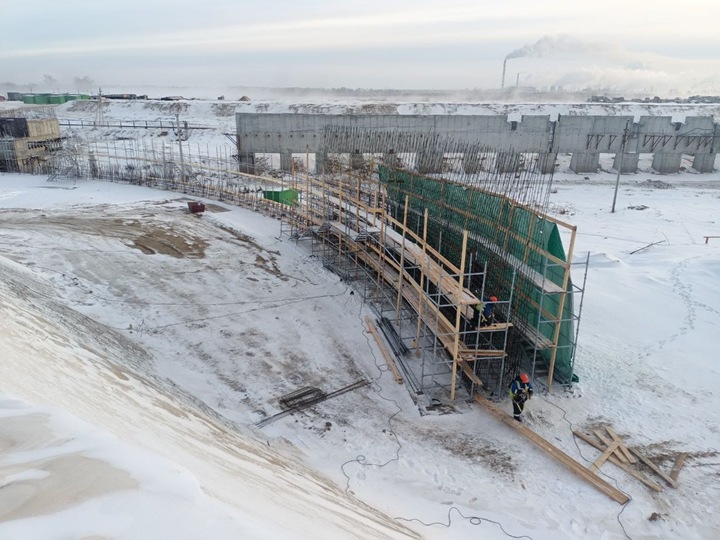Afghanistan is building the Koshtepa Canal, Uzbekistan is calling for dialogue
The construction of the Koshtepa canal in Afghanistan may be completed in 2028, the Minister of Water Resources of Uzbekistan said. According to him, the Afghan side has the right to Amu Darya water, and disputes should be resolved peacefully. Earlier, the Center for National Interests of the United States warned about the influence of the channel on the region.

The Koshtepa Canal, which is being built by the interim government of Afghanistan to take water from the Amu Darya, is scheduled to be completed by 2028. This was announced by the Minister of Water Resources of Uzbekistan Shavkat Khamraev on March 18 at an open meeting with members of the Public Council under the Ministry and media representatives, the correspondent reports “Газеты.uz “.
Answering a question from journalists about when the Koshtepa Canal will begin to influence Uzbekistan, the minister noted that the Afghan side also has the right to take water from the Amu Darya.
“Frankly speaking, Afghans are our relatives. They also have the right to take water from the Amu Darya. Now they are writing on the web: They are building a Koshtep, something is happening… Do we have to take up arms and go to war? No, it’s not. We are building relationships, conducting a dialogue, and maintaining family ties. Gradually we will explain to them that they need to take their share of water. Then there will be documents, negotiations, working visits — all this will be discussed,” Shavkat Khamrayev said.
According to him, it is necessary to maintain good-neighborly relations and not attach importance to various rumors and speculations.
He recalled that for many years the construction of various water bodies in Tajikistan and Kyrgyzstan was discussed, and this led to an increase in tension between the peoples.
“Do not give in to empty talk. For example, if you are told that a neighbor looks askance at your daughters or throws stones at your car, the mood will deteriorate,” he said, adding with a smile that it is better to avoid omissions by inviting a neighbor to iftar.
“Just take a pilaf in the evening, go to a neighbor and see what a good person he is. He will also respond to you with kindness. Now it happens that some do not even know their neighbors. Where are our old customs? Therefore, we must be closer to our neighbors and build good relations. For this, I pay my respects to our esteemed president — thanks to his efforts, the ice between the neighbors has melted, relations have improved,” the minister stressed.
Shavkat Khamrayev said that he had recently visited Afghanistan four times, where the Uzbek delegation was received “as relatives.” According to him, representatives of the Afghan side assured that “they will not upset us” on the issue of the Koshtep channel.
“I hope for the best. Peace and stability in Afghanistan are also important for us, and, of course, all issues, including water issues, will be resolved in stages. If the construction of the Koshtepa canal continues at the same pace, it will be completed by 2028,” said the head of the Ministry of Water Resources of Uzbekistan.
Recall that in June 2023, the minister said that Uzbekistan was ready to assist the Afghan side in the construction of the canal. Then he stressed that “this channel is not to pit nations against each other, but to unite. It will be a channel of friendship.”
In addition, Shavkat Khamrayev then noted that Afghanistan plans to irrigate about 300 thousand hectares of land using the canal, which will require 4-5 billion cubic meters of water, and Uzbekistan will strive to preserve this volume of water.
About the Koshtepa Channel
According to the Afghan media, the length of the first section of the canal is 108 km — it originates from the Amu Darya River and reaches the Davlatabad district of Balkh. Its construction lasted 1.5 years.
In October 2023, the Taliban announced the completion of the first section of the Koshtepa Canal in Afghanistan and the start of the second phase of the project. The Taliban asked the countries of the region, especially Uzbekistan, not to worry about the channel and said they were ready to resolve issues “through diplomatic channels.”
At the second stage, it is planned to build a 177 km long section of the canal passing through the provinces of Jauzjan and Faryab. The third stage will include the distribution of subchannels on agricultural land.
The total length of the canal will be 285 km. According to the plan of the Afghan authorities, it will allow to irrigate up to 550 thousand hectares of land, which will make it possible to grow wheat and other crops.
The full completion of the project is scheduled for 2028, its cost is estimated at 7 billion Afghanis (about $ 92 million).
The issue of the construction of the canal was also raised by the President of Uzbekistan Shavkat Mirziyoyev.
“In fact, a new participant in the water use process has appeared in our region, which is not bound by any obligations with our countries,” the head of state said at the time, speaking at the summit of the Fund for Saving the Aral Sea in Dushanbe in September 2023.
He proposed to form a working group to study the impact of the canal on the Amu Darya water regime and invite representatives of Afghanistan to a dialogue on water resources in the region.
Impact on the Central Asian region
In November 2024, the US Center for National Interests published a report on the Koshtep Canal in Afghanistan and the impact on the security of water resources in Central Asia.
It says that the construction of the canal will have a serious impact on the availability of water for irrigation and drinking water supply in one of the most water—scarce regions of the world – Central Asia. In addition to the existing problems with water supply, the Amu Darya basin and the entire Central Asian region are facing the consequences of climate change occurring here much faster than the global average.
In Uzbekistan and Turkmenistan, agriculture consumes about 90% of all water resources. The sector’s contribution to GDP is 17% in Uzbekistan and 10% in Turkmenistan, while a significant proportion of water is spent on cotton cultivation.
It is noted that the interim authorities of Afghanistan face serious financial, technical and diplomatic challenges in order to complete the construction of the canal efficiently, sustainably and peacefully.
“The region cannot allow the canal to be built as unsuccessfully as the Soviet canals on the Amu Darya, which, even decades after their creation, continue to negatively affect regional water security. The Soviet legacy also excludes Afghanistan from key agreements on the distribution of water resources,” the report says.
The Center recommends that the United States use the opportunity provided by this project to establish interaction with the interim authorities of Afghanistan. This is necessary to ensure the construction of a well-designed canal that will make the most efficient use of water resources in Afghanistan.
If the United States supports the project or at least does not seek to block it, it is more likely that multilateral financial institutions — such as the World Bank, the European Bank for Reconstruction and Development and the Asian Development Bank — will provide financial, technical and diplomatic support to the project, the organization believes.
The Center also indicated that the United States should cooperate with multilateral development institutions to ensure that technical assistance, including consulting services, is provided to the interim Afghan authorities. This concerns not only the construction of the canal itself, but also the creation of a much wider irrigation system that it should serve.
Afghanistan is experiencing a shortage of technically trained personnel for the implementation of a complex canal construction project and the formation of a modern national water resources management system. One of the key problems is the shortage of highly qualified hydraulic engineers, many of whom left the country after the Taliban came to power. Some important ministries and government bodies, which are headed by technocrats in other countries, are headed by mullahs in Afghanistan, the report notes.
“The United States should gather allies and partners to support diplomatic efforts to conclude a regional agreement on the distribution of water resources with the participation of Afghanistan. At a minimum, Afghanistan, Kazakhstan, Kyrgyzstan, Tajikistan, Turkmenistan and Uzbekistan should participate in such an agreement. Many countries around the world have similar cross—border agreements on water regulation, and their experience can help in the development of a new treaty,” the US Center for National Interests said.
Washington was also encouraged to work with allies, partners and multilateral institutions to support downstream countries — especially Turkmenistan and Uzbekistan — through additional investments and technical assistance in upgrading their own irrigation systems using Amu Darya waters.
The construction of the Koshtepa canal is carried out in conditions of limited resources and time pressure. However, hydraulic engineering experts warn that non-compliance with modern engineering standards can lead to serious environmental degradation. As noted in the article CABAR.asia In 2023, experts are particularly concerned that the bottom of the canal is not lined with concrete or geotextile materials, which is critical to prevent significant water losses due to filtration into sandy soils.
There is also a concern that the operation of an uncoated channel may increase soil salinization. Another problem is the lack of mechanisms to remove silt from the waters of the Amu Darya, which already carry a large amount of precipitation. This will lead to a gradual decrease in the efficiency of the channel.
However, some experts believe that the fears may be exaggerated. A study by the German Economic Team from 2023 shows that even if the Koshtepa Canal diverts 25% of the Amu Darya water, this will only lead to a decrease in Uzbekistan’s GDP by 0.7% by 2030. One of the co-authors of the report, a researcher in the field of water resources and the environment, Najibullah Sadid, argues that at this stage water consumption in agriculture will not be significant, since subchannels for supplying water to the fields have not yet been built, and the fields themselves have not yet been prepared for cultivation.
“Газета.uz “


